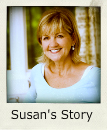Many of you who read this blog are my clients; others of you do a bit of a double-take when I reference clients, like I did last week. Maybe you think I have an active fantasy life with lots of imaginary pals. I wish.
I thought for those of you who may wonder what exactly it is I do when people hire me as a leadership coach, I’d give you a glimpse inside that world of one-on-one personal coaching. If you prefer to live in ignorance and not mess with the mystery, I can respect that. Stop reading now and see you next week.
When I coach you, there’s a lot of stuff that happens at the beginning of our relationship, and then of course stuff that happens at the end — not a lot of that because I HATE goodbyes so I have gotten awesome at avoiding them.
But in the middle of our relationship, after we’ve had the DTR and we’re not yet hyperventilating about separation (okay that’s more me than you), we have calls or Skypes or coffees or meals or walks, and we talk. Our conversation lasts as long or as short as it needs to. You have my undivided attention, unless I’m driving, and I try not to do that when we’re talking. And, I ask you the following questions. I don’t use these exact words, but the order and flow is pretty much consistent.*
* What is the most important thing you and I should be talking about right now?
* Tell me more about that. What’s going on with it that makes it critical to you today?
* How (else) is this currently affecting you? Who or what else is being impacted? How does that relate to this, which we talked about last time? (I usually ask this question about 3 different times, in different ways. It’s always enlightening to see how far -reaching the impact of one issue or scenario can be.)
* What will happen if you do nothing about this? Tell me the implications of nothing changing with this situation. Imagine it is a year from now, and this comes up again. What is likely to have happened between now and then?
I usually take a deep breath before I ask the next question. You know it’s coming, so you’re prepared. I ask it every time, but I care very much about creating a safe and non-threatening space for you to process and grow. So I make sure I don’t sound like your mom or your judge or your own critical inner voice when I ask:
*How have you helped create the current situation?
Typically, you know the question is coming, and you’ve thought about it a bit, so you’re careful not to sound defensive. Your answer is either a superficial one that you think sounds like something a good student of self-leadership would say “I avoided having the hard conversation when my feelings first came up;” or you tell me you honestly don’t know because your mom/boss/boyfriend just did this thing that had nothing to do with you/came out of the blue/is totally the opposite of anything you ever intended or wanted. So then I say:
* If you had to guess at your involvement, even if it’s just what did they think you would do/say in this scenario, or maybe backing up to earlier in your relationship or process, before this latest issue– is there any way you can think of where you may have communicated or not communicated something, either intentionally or not? Can you imagine any world in which someone could have believed differently about you or about this issue? Do believe that you have any part in that at all?
We usually take a while with that. It’s kind of the dig-down-deep into your self-leadership part of the whole deal. Next, I ask:
* What is the ideal outcome for you now? (This is known in counseling circles as “The Magic Question.” The relief is palpable when we get to here. It’s like the light at the end of the tunnel finally begins to shine upon your face.) Describe it to me, as specifically as possible. How will it feel to wake up in the morning, the day after this is resolved? What will you do first? Second? Tell me about the difference this outcome will make in your life. When you think about that difference, how do you feel?
* With that in mind, what’s the most potent step you can take to begin to resolve this issue? Knowing what you know now, what is your responsibility here? What exactly are you committed to do, and when will you do it?
There you have it. It’s not curing cancer, but it’s way better than the alternative.
I thought about including a sample from a client, so you could see us go through an issue step-by-step, but this post is already pretty long and dense. Let me know if you think it would be helpful to see it unfold with the questions in real time, though, and I might do that for a later post.
For now, feel free to insert your own issue into the process I describe above. Maybe it’s your grouchy neighbor who complains about you to the landlord 5 times a day when you’re not even home. Or a family member who has no respect for your boundaries or privacy. Perhaps a co-worker that makes you throw up a bit in your mouth every time you see him or her.
It could be a longing that has gone unfulfilled for years now, and you wonder when or if you will ever be able to pray and hope for something else. Maybe it’s a wound that hasn’t healed, or a question that remains unanswered. Something that is either preventing you from getting where you need to go, or a destination you desire to reach but are realizing you need a map, if not a guide, to help you get there.
Whatever it is, when you face it, I’m there facing it with you. The moment you find yourself in need of greater insight, shrewdness, or courage, I’m all in. So you can be known and not alone.
Can’t wait for our next conversation.
*Adapted from “Fierce Conversations,” by Susan Scott











“Perhaps a co-worker that makes you throw up a bit in your mouth every time you see him or her.” haha! Love ur show! One day I’m gonna hire u to fix me too:))